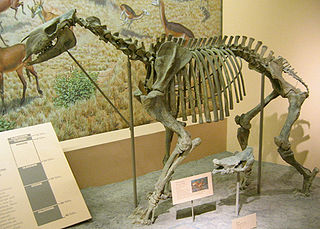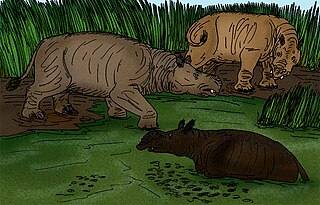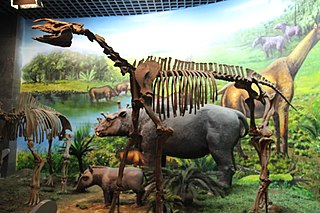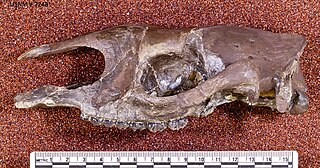
Perissodactyla is an order of ungulates. The order includes about 17 living species divided into three families: Equidae, Rhinocerotidae (rhinoceroses), and Tapiridae (tapirs). They typically have reduced the weight-bearing toes to three or one of the five original toes, though tapirs retain four toes on their front feet. The nonweight-bearing toes are either present, absent, vestigial, or positioned posteriorly. By contrast, artiodactyls bear most of their weight equally on four or two of the five toes: their third and fourth toes. Another difference between the two is that odd-toed ungulates digest plant cellulose in their intestines, rather than in one or more stomach chambers as even-toed ungulates, with the exception of Suina, do.

Eutamias is a genus of chipmunks within the tribe Marmotini of the squirrel family. It includes a single living species, the Siberian chipmunk. The genus is often treated as a subgenus of Tamias, which is now restricted to the eastern chipmunk of North America. Neotamias, which now includes the western North American chipmunks, has also been included in Eutamias.

Paraceratherium is an extinct genus of hornless rhinocerotoids belonging to the family Paraceratheriidae. It is one of the largest terrestrial mammals that has ever existed and lived from the early to late Oligocene epoch. The first fossils were discovered in what is now Pakistan, and remains have been found across Eurasia between China and the Balkans. Paraceratherium means "near the hornless beast", in reference to Aceratherium, the genus in which the type species P. bugtiense was originally placed.

Paraceratheriidae is an extinct family of long-limbed, hornless rhinocerotoids native to Asia and Eastern Europe that originated in the Eocene epoch and lived until the end of the Oligocene.

Chalicotheriidae is an extinct family of herbivorous, odd-toed ungulate (perissodactyl) mammals that lived in North America, Eurasia, and Africa from the Middle Eocene until the Early Pleistocene, existing from 48.6 to 1.806 mya. They are often called chalicotheres, a term which is also applied to the broader grouping of Chalicotherioidea. They are noted for their unusual morphology compared to other ungulates, such as their elongated clawed forelimbs. They are thought to have been browsers.

Amynodontidae is a family of extinct average-sized rhinocerotoids. They are commonly portrayed as semiaquatic hippo-like rhinos but this description only fits members of the Metamynodontini; other groups of amynodonts like the cadurcodontines had more typical ungulate proportions and convergently evolved a tapir-like proboscis.
Nestoritherium is an extinct genus of chalicothere; it has been dated to have lived from the late Miocene to the Early Pleistocene. This range makes Nestoritherium one of the most recently dated chalicotheres. It has been found in fossil sites in Myanmar and China.

Juxia, ‘joo-she-a’, is an extinct genus of paraceratheriid, a group of herbivorous mammals that are related to the modern rhinoceros. The type species is Juxia sharamurenensis, named by Zhou Mingzhen and Qiu Zhanxiang in 1964. Juxia was around the size of a horse. It lived in Asia during the upper Eocene.
The Irdin Manha Formation is a geological formation from the Eocene located in Inner Mongolia, China, a few kilometres south of the Mongolian border.

Rhinocerotoidea is a superfamily consisting of five families of odd-toed ungulates, four of which, the Amynodontidae, Hyracodontidae, Paraceratheriidae and Eggysodontidae, are extinct.The only extant family is the Rhinocerotidae, which survives as five living species.Extinct non-rhinocerotid members of the group are sometimes considered rhinoceroses in a broad sense. The family Paraceratheriidae contains the largest land mammals known to have ever existed.
Eggysodon is an extinct genus of odd-toed ungulate belong to the rhinoceros-like family Eggysodontidae. It was a small, ground-dwelling browser, and fossils have been found in Oligocene deposits throughout Europe. Eggysodon may have been related to Preaceratherium, and both had tusklike canines and smaller, and fewer, incisors.
Urtinotherium is an extinct genus of paracerathere mammals. It was a large animal that was closely related to Paraceratherium, and found in rocks dating from the Late Eocene to Early Oligocene period. The remains were first discovered in the Urtyn Obo region in Inner Mongolia, which the name Urtinotherium is based upon. Other referred specimens are from northern China.
Olbitherium is an extinct mammal of the order Perissodactyla from the early Eocene epoch of Shandong, China.

Forstercooperia is an extinct genus of forstercooperiine paraceratheriid rhinocerotoids from the Middle Eocene of Asia.
This paleomammalogy list records new fossil mammal taxa that were described during the year 2011, as well as notes other significant paleomammalogy discoveries and events which occurred during that year.

Helaletes is a genus of an extinct perissodactyls closely related to tapirs. Fossils have been found in North America.

Pappaceras is an extinct genus of rhinocerotoids from the Early Eocene of Asia belonging to Paraceratheriidae.
Allacerops is an extinct genus of odd-toed ungulate belong to the rhinoceros-like family Eggysodontidae. It was a small, ground-dwelling browser, and fossils have been found in Oligocene deposits throughout Central and East Asia.

Dzungariotherium is a genus of paraceratheriid, an extinct group of large, hornless rhinocerotoids, which lived during the middle and late Oligocene of northwest China. The type species D. orgosense was described in 1973 based on fossils—mainly teeth—from Dzungaria in Xinjiang, northwest China.
Aralotherium is an extinct genus of hornless rhinocerotoids closely related to Paraceratherium, one of the largest terrestrial mammals that has ever existed. It lived in China and Kazakhstan during the late Oligocene epoch. It is classified as a member of the Paraceratheriidae subfamily Paraceratheriinae.










